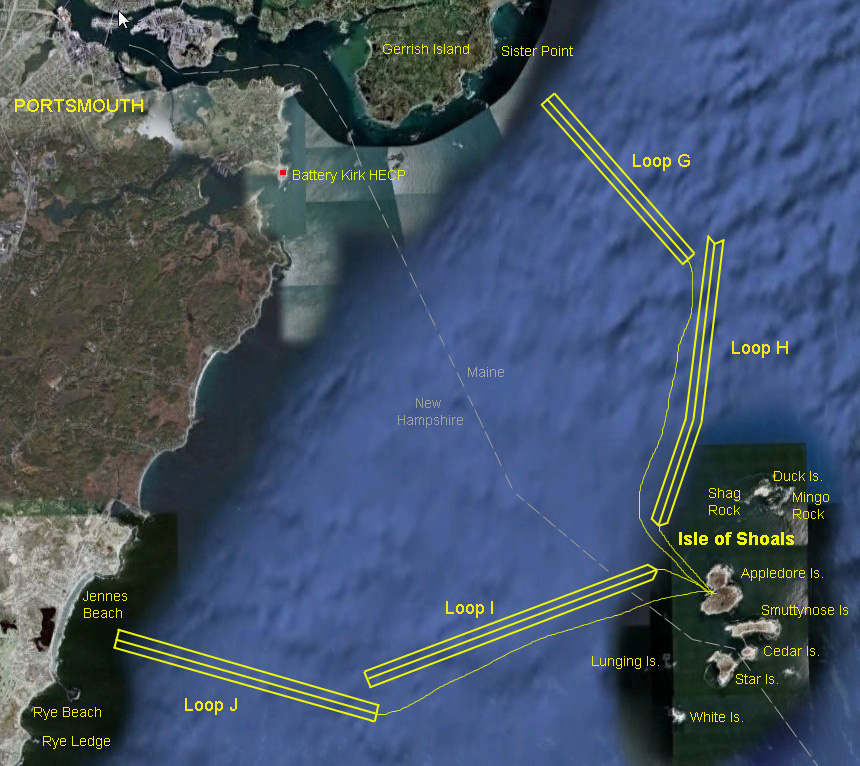
AROUND THE WORLD
Anti-submarine Indicator Loop stations in the United States
Portsmouth Loop Receiving Station
Appledore Island, Maine, USA
Drawing by Gerry Butler

Appledore Island, Maine, USA
Drawing by Gerry Butler
Indicator Loops are long lengths of cable laid on the seafloor of harbours to detect enemy submarines. They were initially developed by the Royal Navy in the early 1900s and by 1942 the United States had adapted this technology for its own needs. This webpage looks at the indicator loop defences in Portsmouth Harbor, straddling the states of Maine and New Hampshire, USA.
If you have any feedback please email me:
Dr Richard Walding
Research Fellow - School of Science
Griffith University
Brisbane, Australia
Email: waldingr49@yahoo.com.auAnti-submarine Indicator Loops
Indicator Loops - an overview (YouTube, 70 minutes)
Indicator Loops were developed by the Royal Navy in the early 1900s and first trialled at the end of WW1. They were successfully deployed in WW2 in British ports and other Commonwealth countries such as Australia, Canada, New Zealand, South Africa, Kenya, Ceylon, Penang, and in allied harbours (Iceland, Holland, Dardanelles). By 1942 the United States had adapted this technology for its own needs and a dozen United States Navy "loop receiving stations" were established along the eastern seaboard of mainland USA particularly at the ports of Boston and Portland. The Pequot was the main cablelayer for the USN's indicator loop harbor defense. The deployment of indicator loops was highly secret and hardly any of the men on the ship knew the purpose of the cables; most thought they were underwater communications cables. The words indicator loop were not used - just cable. The sailors manning the loop huts were given rudimentary (3 week) training in harbor detection by indicator loops and sono-radio-buoys. To find out more about the role of the Pequot go to the USCG cableship Pequot webpage.
This diagram shows the arrangement of the cables in the loop ("3-legged") and the tail cable connecting them to the control station. This type was used throughout the USA.
 |
|
The Indicator Loop field at Portsmouth. The loop control hut (the "loop receiving station") was on Appledore Island, Maine. The other harbor defenses (mines and hydrophones are shown below). The Harbor Entrance Control Post (HECP) was at Battery Kirk, a part of Fort Stark. A closer view of Battery Kirk is shown further down. |
 |
|
The minefield and hydrophone array at Portsmouth - also showing the locations of the control stations. |
 |
|
A sample of a loop chart similar to that used at Appledore. This shows the signature of DD463 USS Corry April 23, 1942, as she passed over loops at Portland, Maine. She was later the US Navy's only major loss on D-Day. The interpretation of the signature and some more examples can be found at: Reading Loop Signatures. (Image courtesy of Martin Dwyer, copied from Waltham Archives in Massachusetts) |
THE HARBOR ENTRANCE CONTROL POST
The role of a Harbor Entrance Control Post (HECP) was to serve as the "…central point for the coordination and joint operation of the Army and Navy elements of the harbor defense system”. In the Spring of 1941, the Army and Navy agreed to this co-operation and it was up to the the Navy to issue guidance for the operations of the HECP. This was published in the form of Naval Harbor Defense manual by the Chief of Naval Operations. The official mission of the HECP was: "To collect and disseminate information of activities in the defensive sea area; to control unescorted commercial shipping in the defensive coastal area; and to take prompt and decisive action to operate the elements of the harbor defense; in order to deny enemy action within the defensive coastal area." [Ref: OPNAV 30-3a]. In October 1941 the Army directed the establishment of HECPs at 18 US Army locations, one of which was at Fort Stark. The building used was the old Battery Kirk which was renovated and added-to.
 |
|
Battery Kirk is part of Fort Stark State Historic Site, Jerry's Point, New Castle Island, New Hampshire. The HECP-HDCP structure is still in place but the area of Battery Kirk and the HECP are now closed to the public for safety reasons. See diagram below for the floor plan. |
 |
|
In 1943-44 a combined Harbor Entrance Control Post (HECP) and Harbor Defense Command Post (HDCP) was built into the magazine structure of the deactivated Battery Kirk. This facility included a new three floor concrete observation station built on top of the magazine structure with an SCR-682 RADAR set on top of that. The observation station structure was disguised as a modernistic building much like a ship's superstructure, with camouflaged paint. The combined HECP-HDCP facility was accepted for service on 10 Jan 1944 at a cost of $ 93,398.77. (http://fortwiki.com/Battery_Kirk) |
 |
 |
|
HECP-HDCP 1944 (Wilbur Hoxie, US Army Corps of Engineers, New England Division) |
HECP 2004 |
An extensive website on the naval defenses of
Portsmouth can be found at: North American Forts- New Hampshire